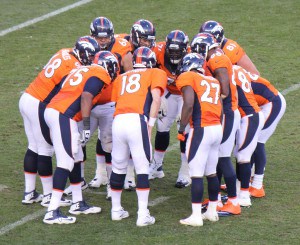
Almost every weekend during football season, we watched the Denver Broncos huddle between plays. In a few seconds, they analyzed the defense, made offensive decisions, called a play and broke to push the ball farther down the grid-iron. Over the course of the year, and throughout success and failure, the Broncos used their huddles to march their way towards a winning season and ultimately the Super Bowl Championship. Talk about communicating to win!
Communication needs structure to be executed successfully and the Denver Broncos’ repetitive huddle provides a great example of that type of structure. In short, their communications inside the huddle performed three critical functions that tied their strategy to win to execution.
The huddle:
- Established a “learning forward” cycle;
- Communicated the overall strategy by breaking it down into play-by-play action;
- Focused the team on the “next best thing to do”.
The Learning Forward Cycle:
Reflecting on previous articles (The Yin and Yang of Strategy and Execution, Wicked to Tame and Strategy on a Napkin), we see that strategy is:
- A complement to execution that must adapt and change;
- A process to deal with non-linear and most likely “wicked” problems in which solutions unfold over time;
- A simple guiding vision that provides clarity and coordinates effort while allowing freedom of execution at lower levels.
Understanding strategy is not the end of the game. Leaders must tie strategy to execution by forging organizational structures that create “learning forward” cycles. From Boyd’s OODA Loop to Sull’s Strategy Loops, research demonstrates the importance of cyclical pauses that allow organizations to analyze execution, make sense of an ever-changing environment (Weick), develop “theories of action” and effectively communicate the next best step.
The best leaders establish “learning forward” structures before strategy is put into action. These cycles:
- Repeat regularly;
- Analyze past actions, performance and results;
- Develop theories of action to determine the next best step;
- Focus the team on precision execution;
- Consistently connect strategy to execution.
Three excellent examples of the learning forward cycles are found in Afterburner’s FLEX Process, Franklin Covey’s 4 Disciplines of Execution and Colman Coaching’s Communicate to Win program for teams.
Communicate Strategy
Organizational players must understand how their actions are tied to the overall strategy. The learning forward structure allows leaders to continually communicate strategy to the players and the players to communicate execution adjustments to the leaders.
For the learning forward cycle to work, strategy must be:
- Captured in a statement that defines the objective, expected outcomes and strengths upon which the team will capitalize on;
- Communicated clearly and simply; and,
- Received and understood by those responsible for execution.
With a clearly communicated strategy, precision execution and a learning forward structure, teams have enough information to choose between improving execution or adapting the strategy 2. For example, perhaps Peyton Manning’s throwing arm was the expected strength at the start of the game, leading to a passing game for the Broncos. However, despite perfect Bronco execution, the defense was prepared for this and effectively countered the passing strategy. Rather than continually pursuing a failing strategy that is evident by conditions on the field, the Broncos adapt their game strategy and switch to a running game.
Focus on the Next Best Play
In the huddle, Manning and his offensive team aren’t talking about how they have to practice blocking next week or any other bigger picture problems: those are topics for huddles between Kubiak and his coaches. They are focused intently on executing the next play to the best of their ability. Only through play-by-play precision execution will Kubiak and his leadership team be able to determine if they need to change strategy.
Your learning forward cycle must focus on executing your next best play given your overall strategic objectives and the ever-changing conditions on your playing field. In every learning forward meeting, you are confirming, revising or developing a new theory of action as to what your next best play should be 4. Creating a short, cyclical process to bring your team together on a regular basis provides the necessary structure that creates a synergy between strategy and execution.
Invest In Your Strategic Structure
As you invest effort into defining and crafting your strategy, invest as much effort in creating the learning forward structure necessary to allow your strategy to be effectively executed. The learning forward structure is simple:
- Create a learning forward cycle around your one or two highest priorities where your team meets on a regular basis (1-2 weeks) for no longer than 15 minutes;
- Ensure your strategy is clear and concise and present in every learning forward cycle meeting to guide execution decisions;
- Establish a firm agenda that:
⁃ Analyzes past execution and results;
⁃ Develops new theories of action for the next best play based on current conditions;
⁃ Focuses the team on executing with excellence the next best play.
Create a macro learning forward cycle where your supervisory team meets once a month and your C-level leadership meets at least once a quarter to ensure execution is aligned with the overall strategy. If results are not being achieved, learn from the execution level about what changes must be made in either execution or strategy to keep progressing towards the overall goal
Whether you are the organizational equivalent of Elway, Kubiak or Manning, establish your learning forward structure. This structure will allow you to effectively execute your strategy, learn from changing conditions and focus your team on your next best play. Season –by-season, game-by-game, and play-by-play, you will march towards your goals by executing, pausing, analyzing, learning, adapting and improving. Like the Broncos, you will win your organizational Super Bowl by creating a structure for your strategy to succeed.
By selecting Colman Coaching as your strategic coaching partner, you are choosing a top performer in the leadership development space, specializing in executive communication and corporate performance.
We will help you find your way ahead to personal and professional success.
by Todd Lancaster, Strategy Coach and Kendall Colman, Excutive Communications Coach
References
The OODA Loop. Enck R. E.Home Health Care Management & Practice 24(3):123-4 (2012)
Strategy and Execution. Sull D. N.MIT Sloan Management Review (2007)
Can you say what your strategy is? Collis D. J. and Rukstad M. G.harvard business review 86(4):82-90 (2008)
Of strategies, deliberate, and emergent. Mintzberg H. and Waters J. A.(1985)


